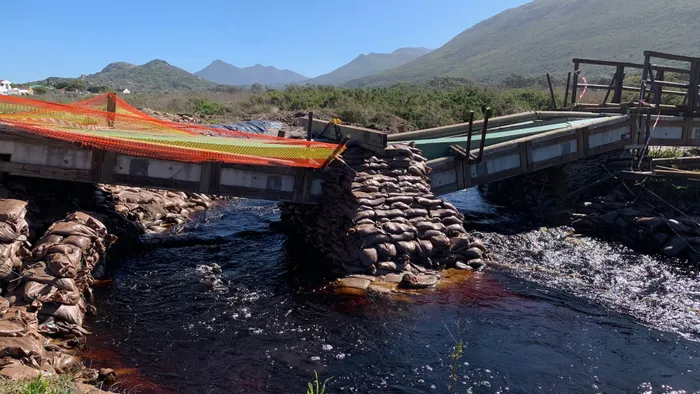Valley power supply in peril

The Lower Silvermine Wetlands bridge supporting Fish Hoek power cables has partially collapsed
The power supply to Fish Hoek relies on cables running through a Lower Silvermine Wetlands bridge that has collapsed.
While the City completed dredging in the wetlands by the end of June in preparation for the western leopard toad breeding season, not all aspects of the project have gone smoothly, according to Dave Balfour, chairperson of Friends of Silvermine Nature Area (Fosna).
“The increased water flow now channelled under the pipe bridge has eroded the ground beneath the supporting pillars, causing some to sink,” he said. “This poses risks to pedestrians and potentially to Fish Hoek’s electricity supply.”
High and medium voltage cables cross the wetlands, housed in pipes supported by the bridge's pillars.
According to Mr Balfour, these cables are designed to bend slightly but can lose their current-carrying capacity if bent too far.
The sinking of one pillar had caused the cables to droop, he said.
“The pillars were originally designed for a laminar, or sheet, flow of water. However, recent work clearing reeds has concentrated the flow around certain pillars, leading to the subsidence of the first one.”
Mayoral committee member for energy Xanthea Limberg said the City had stabilised the bridge to protect the electricity supply to the valley after recent heavy rains and abnormal water flow had dislodged the bridge’s support piers, compromising its structural integrity.
“The primary focus is on stabilising the cables and obtaining approvals for rerouting them off the bridge, a process expected to take several months.
“In the meantime, the bridge piers have been stabilised as much as possible, and the high-voltage cables are temporarily supported,” she said.
For public safety, the bridge has been closed.
“The bridge is no longer safe for pedestrian use. Structural reports indicate that the bridge cannot be rehabilitated or repaired in its current location,” Ms Limberg said.
“Alternative arrangements will need to be made to re-establish a pedestrian walkway,” she added.
Meanwhile, Fosna committee member Martin Scholtz said the dredging in late 2023 and 2024 had transformed a dense reed bed into a more open habitat.
“It’s remarkable how much more secure people feel in this new space,” he said.
Heavy rains had created open water bodies in the area, but Mr Scholtz said water levels were likely to drop as the weather improved.
He said Fosna had applied for City funding to plant wetland vegetation to stop the south-easter from whipping up sand in the wetland.